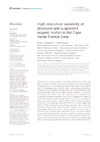Identificador persistente para citar o vincular este elemento:
https://accedacris.ulpgc.es/jspui/handle/10553/119925
| Título: | High-resolution variability of dissolved and suspended organic matter in the Cape Verde Frontal Zone | Autores/as: | Campanero, Rubén Burgoa, Nadia Fernández-Castro, Bieito Valiente, Sara Nieto-Cid, Mar Martínez-Pérez, Alba M. Gelado Caballero, María Dolores Hernández Hernández, Cristo Nauzet Marrero Díaz, María De Los Ángeles Machín Jiménez, Francisco José Rodríguez Santana, Ángel Hernández García, Inés Delgado-Huertas, Antonio Martínez Marrero, Antonio Arístegui Ruiz, Javier Álvarez-Salgado, Xosé Antón |
Clasificación UNESCO: | 251002 Oceanografía química 251001 Oceanografía biológica |
Palabras clave: | Cape Verde Frontal Zone Carbon Cycling Colored Dissolved Organic Matter Dissolved Organic Matter (Dom) Fluorescent Dissolved Organic Matter (Fdom), et al. |
Fecha de publicación: | 2022 | Proyectos: | Sustainable management of mesopelagic resources Impacto biogeoquímico de procesos a mesoescala y submesoescala a lo largo del ciclo de vida de remolinos ciclónicos y anticiclónicos:variabilidad planctónica y productividad Flujos de Carbono en Un Sistema de Afloramiento Costero (Cabo Blanco, Nw de Africa). Papel Del Carbono Disueltoy en Suspension en El Contexto de la Bomba Biologica. Flujos de Carbono en Un Sistema de Afloramiento Costero (Cabo Blanco, Nw de África); Modulación A Submesoscala de la Producción, Exportacióny Consumo de Carbono |
Publicación seriada: | Frontiers in Marine Science | Resumen: | Distributions of dissolved (DOM) and suspended (POM) organic matter, and their chromophoric (CDOM) and fluorescent (FDOM) fractions, are investigated at high resolution (< 10 km) in the Cape Verde Frontal Zone (CVFZ) during fall 2017. In the epipelagic layer (< 200 m), meso- and submesoscale structures (meanders, eddies) captured by the high resolution sampling dictate the tight coupling between physical and biogeochemical parameters at the front. Remarkably, fluorescent humic-like substances show relatively high fluorescence intensities between 50 and 150 m, apparently not related to local mineralization processes. We hypothesize that it is due to the input of Sahara dust, which transports highly re-worked DOM with distinctive optical properties. In the mesopelagic layer (200-1500 m), our results suggest that DOM and POM mineralization occurs mainly during the transit of the water masses from the formation sites to the CVFZ. Therefore, most of the local mineralization seems to be due to fast-sinking POM produced in situ or imported from the Mauritanian upwelling. These local mineralization processes lead to the production of refractory CDOM, an empirical evidence of the microbial carbon pump mechanism. DOM released from these fast-sinking POM is the likely reason behind the observed columns of relatively high DOC surrounded by areas of lower concentration. DOM and POM dynamics in the CVFZ has turned out to be very complex, in parallel to the complexity of meso- and submesoscale structures present in the area. On top of this high resolution variability, the input of Sahara dust or the release of DOM from sinking particles have been hypothesized to explain the observed distributions. | URI: | https://accedacris.ulpgc.es/handle/10553/119925 | ISSN: | 2296-7745 | DOI: | 10.3389/fmars.2022.1006432 | Fuente: | Frontiers in Marine Science [EISSN 2296-7745], v. 9, (Noviembre 2022) |
| Colección: | Artículos |
Citas SCOPUSTM
4
actualizado el 08-jun-2025
Citas de WEB OF SCIENCETM
Citations
4
actualizado el 08-jun-2025
Visitas 10
194
actualizado el 25-ene-2025
Descargas
192
actualizado el 25-ene-2025
Google ScholarTM
Verifica
Altmetric
Comparte
Exporta metadatos
Los elementos en ULPGC accedaCRIS están protegidos por derechos de autor con todos los derechos reservados, a menos que se indique lo contrario.
